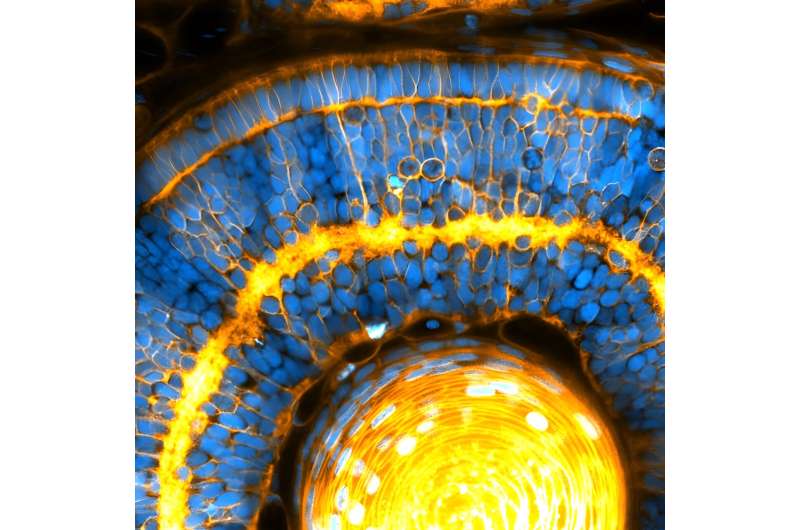This article has been reviewed according to Science X's editorial process and policies. Editors have highlighted the following attributes while ensuring the content's credibility:
fact-checked
peer-reviewed publication
trusted source
proofread
The hidden architect: How nuclei organize the eyes and brain

Inside each cell, individual structures known as organelles perform key functions, but how these organelles contribute to the formation of tissues and organs is unknown. New research from the Campàs group at the Cluster of Excellence Physics of Life of TU Dresden now reveals that the cell's nucleus controls the stiffness of eye and brain tissues, and even the ordered arrangements of cells in them. These results add a new role for the cell's nucleus in tissue organization, well beyond its established role in genetic regulation.
Our lives are defined by interactions. Just as people associate with one another, our cells are no different. During development, constant physical interactions between cells give rise to embryonic tissues and organs. Like factories or roads in cities, a myriad of organelles perform tasks inside cells for them to properly function. Because they are confined within cells, organelles were not believed to play a direct role in building organs during embryogenesis. Until now.
The cell's nucleus is known for processing information in cells, with genes turning on and off depending on the signals received. However, the nucleus is also the largest and stiffest organelle in cells, and could affect the physical structure of the tissue in addition to processing information.
Otger Campàs, Professor and Chair of Tissue Dynamics at the Cluster of Excellence Physics of Life of TU Dresden, where he also serves as Managing Director, was particularly fascinated with how the physical properties of the nucleus could play a role in tissue formation. Building on work started during his previous position at the University of California, Santa Barbara, Professor Campàs decided to study the role of nuclei in the formation of the vertebrate eye and brain.
He explains, "We were measuring tissue stiffness in the zebrafish retina, and realized that it depended on the packing of nuclei. This was totally unexpected because tissue mechanics is believed to depend on cell surface interactions, but not organelles inside cells." This was a new, unexplored avenue of research that was essential to understand how cells orchestrate embryonic development.
Previous pioneering work by his group had found how forces acting between cells can "melt" the tissue into a fluid state to shape embryos. Now they have discovered that nuclei can pack so strongly that they eventually rigidify the tissue.
As co-first author Sangwoo Kim states, "By extending the Active Foam Model, we identified a new mode of solid-to-fluid transition, governed by the relative nucleus and cell sizes."
When the authors investigated the relative size of the nucleus in both experimental and theoretical settings, they found that if the nucleus was taking up much of the cell space, then the tissue stiffness was directly controlled by the nucleus. Moreover, they also found that when the nuclei packed so strongly, they ordered the cells into nearly crystalline arrays.
"When the nuclei start to interact mechanically, both tissue mechanics and cellular ordering are not dictated by the cell surface, but rather controlled by the nucleus itself. This is an organelle determining the stiffness of the entire tissue," according to Campàs. Their study, published today in Nature Materials, challenges the status quo, revealing a new role for nuclei in the control of tissue organization and mechanics.
To explore how the size of the cell's nucleus affects organ formation, the researchers employed zebrafish. These vertebrates are an invaluable model to explore developmental questions, as they are fully transparent during their embryonic stages and mature rapidly, allowing the visualization of organ formation in 3D.
"We therefore conducted structural measurements and cell movement quantifications, focusing on the developing retina and brain of zebrafish," says co-first author Rana Amini.
With these measurements, the authors demonstrated that changes in cell and nuclear sizes during key stages of development "jam" the nuclei into place, as they become tightly surrounded by their neighbors. During this transition, nuclei neatly fit together, like coffee beans in a jar, and this organization may be important for the eye to function.
In our eyes, the packing of cells is very structured, often displaying a crystalline order necessary to process visual cues. In zebrafish it is no different, and the "crystalline" order of cells appears to be a result of the jamming of nuclei as the eye develops.
Beyond the eye, the team also found that brain tissues become nuclear jammed, revealing a new role for the nucleus to control the architecture of several neural tissues. This work also highlights a potential role for defects at the nuclear level to cause diseases associated with impaired tissue architecture. With this new piece of the puzzle, we are one step closer to understanding how cells build organs during embryonic development.
More information: Sangwoo Kim et al, A nuclear jamming transition in vertebrate organogenesis, Nature Materials (2024). DOI: 10.1038/s41563-024-01972-3
Journal information: Nature Materials
Provided by Dresden University of Technology





















